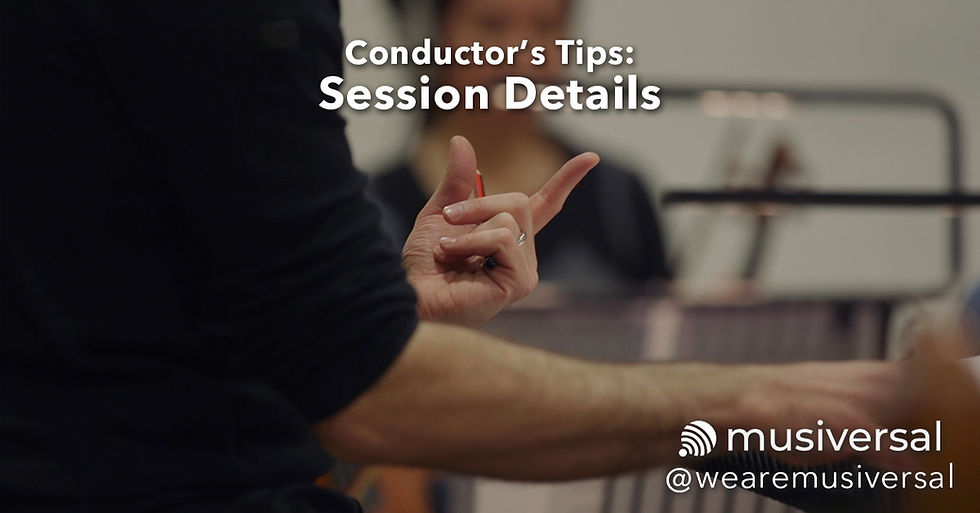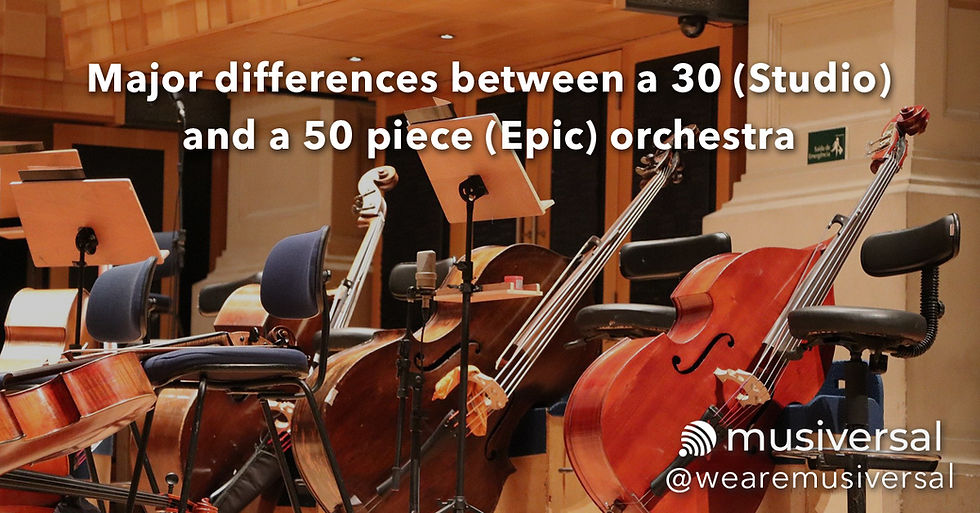Conductor’s Tips: Musical Technique / Orchestration
- Musiversal Team

- Apr 3, 2020
- 5 min read
A Three Part Series On Writing Effectively For Studio Sessions (part II)
The orchestra is a very complex machine composed of various different parts with distinctive roles. Learning how to work with this machine is a process that takes years, and yet many composers will sometimes need to use the orchestra for a recording without being extremely familiar with it.

A pop music producer/writer might want to use a string orchestra in the background of a song. A composition student might wish to try out writing a small orchestra piece, despite some inexperience. An amateur musician might want to tackle a creative challenge completely different from what he/she is used to.
This second post of this three part series brings together a series of tips addressing common lapses in orchestration, and purely musical choices to be made while composing for the orchestra.
Write dynamics! – - Composers who are familiar with notation and writing for orchestra will always, without exception, write dynamic markings. To execute dynamics is something as natural and essential to an orchestra musicians as reading treble clef, and an experienced player looking at a score without dynamics will in the very least feel slightly perplexed. At a minimum one dynamic at the beginning of the piece is essential, and there might be circumstances where one single dynamic marking (the most general being forte, mezzo-forte or piano) will suffice, although this will seldom be the case. This is not the place for a thorough explanation on the possibilities offered by dynamics, but since every once in a while we get a completely dynamic-less score, it is important to advise all composers who are unfamiliar with its possibilities and its necessity to definitely try to learn more on the subject.
Write articulation! – Everything just said about dynamics also applies to articulation, another essential aspect of writing for orchestra. Composers without experience in writing for orchestra will benefit from researching on the subject, as it will allow their musical ideas to be more faithfully realized. If necessary, ask the advice of the conductor or of an arranger, but be sure to do it plenty of time before the actual recording day. Leaving it all for the conductor to decide at the last minute is the worst possible scenario, since not only the result might not be exactly what you wished for, but also time might be lost during the recording (if the conductor only receives the scores right before the session).

Dynamic/articulation details – - While for a concert piece a certain level of ambiguousness and even imprecision in some aspects of notation can be desirable, for a quick recording session clarity is the key to success. Both dynamics and articulation should be written in a way that raises no questions. The most common lapse is writing crescendos/diminuendos (especially when one follows the other) without starting/ending dynamics. This is especially true when a particular dynamic scheme is repeated, leaving doubts in terms of continuity. Sometimes articulation can still be ambiguous even when correctly notated, in those cases it can be helpful to use expressive text to clarify.

Excessive subtlety in dynamics – Too slight dynamic details can be impossible to perform, so it is important to balance subtlety with practicality. For example: writing a crescendo from ppp to pp and back on a horn will rarely produce any effect whatsoever if the player sticks to the written dynamics (most experienced hornists won’t). These “problems” usually fix themselves, but having a score devoid of them will reveal much more experience.
Single violin line – Rarely there might be a context in which writing for all violins as a unit is sensible (ex: a unison monody). Yet sometimes, beginner orchestrators will only write one violin line, while still using the rest of the strings. This can lead to balancing issues, as generally on studio orchestras there will be at least (often more) as many violins as there are other string instruments. Unless you specifically want only one violin line for a very particular reason, it will probably be a mistake not to write different lines for the 1st/2nd violins.
Instrument ranges – With the current availability of learning materials it is almost unforgivable to write notes outside of an instrument’s range (for an unexperienced composer, having an orchestration manual close by is mandatory when writing), and fortunately only very rarely does this happen. Even so, often there are scores that extensively use extreme ranges. This is in no way forbidden, however it can be a liability in the hands of a less experienced orchestrator. Use these ranges only if you are very familiar with how they work, in order to avoid intonation/timbre/dynamic problems.
Triple/Quadruple stops – Much like with instrument ranges, there are many easily available orchestration resources with lists of possible triple and quadruple stops for all string instruments. Unless you are a violinist or you have a good knowledge of how string chords work, make sure to review them before submitting your score.
Virtuoso writing – - Very fast scales or arpeggios (no matter the instrument playing them) or big register leaps should not be written unless you are absolutely sure these will work, either by being able to play the instrument at hand, or checking with a professional musician. Needless to say, even if a passage is technically possible, that doesn’t mean that it can be successfully handled in a short amount of studio time (very complex rhythms fit this category). Be very wary of unnecessary virtuosity, just a couple of very difficult measures might be enough to ruin an otherwise good recording.

Excessive divisi – Divisi can be a double-edged sword, being a tool that can greatly expand the textural qualities of a piece, but also lead to very weak sounding strings. Less experienced composers tend to think that having many lines will contribute to a fuller sound, while in fact the opposite is true. Unless you have a very clear idea of how you want the orchestra to sound, and can confidently put it in paper, it is best to use divisi sparingly, and for the most part only on the 1stviolins. Naturally, when writing for a larger string group (above 10/8/8/6/4), divisi will become a safer option.
Divisi nomenclature – When writing a piece that uses divisi throughout, keep to the standard string family numbering (as in: Violin I 1 / I 2 / II 1 / II 2; rather than: Violin 1 / 2 / 3 / 4). This will ensure the parts are correctly distributed before the session, and avoid confusion regarding who plays what during the session itself.
Extended techniques – When using extended techniques make sure to notate them as clearly as possible, writing performance notes on a separate page of the full score. Ideally, if there are a lot of different techniques on a piece, footnotes should be written on the bottom of the score at every page a new technique comes up (both on the full score and parts), as it is very hard to remember a large number of non-standard notation devices on a short amount of time.
Following all of these tips while writing a piece will prevent technical issues (of instrumental performance) from arising, help balance the orchestration, and ensure the standard orchestral expressive devices (dynamics and articulation) are used correctly. The final post from this series will present a set of tips mostly regarding issues unrelated to the musical score itself.



Comments